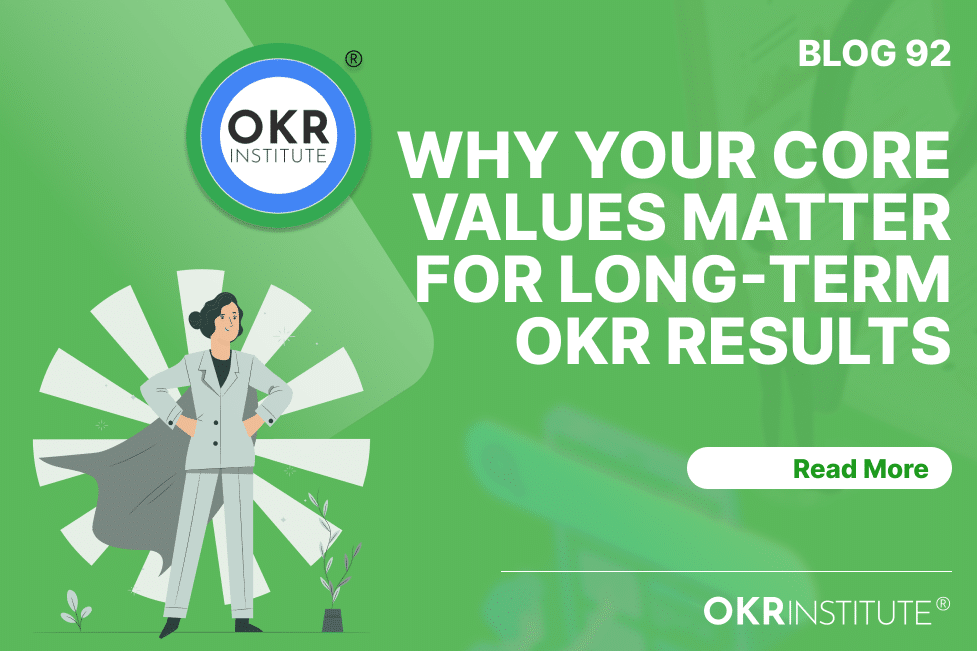6 Empowering leadership styles to optimize OKR performance

6 Empowering Leadership styles to optimize OKR Performance.
The word culture comes from the Latin root, ‘cultus’, which means to care. Caring for each other as a team, wanting to have the best for each other, and also getting the best out of each other, lie at the heart of team and OKR performance.
Leaders or the leadership of the company are the custodians of the culture, and they set the tone of and environment for team engagement and performance. It is the central purpose of leaders to create more leaders thereby ensuring sustainable performance and impact.
Once OKRs are set it is up to a values-based culture , strong leadership and teamwork excellence whether the same OKRs will be actualized,
‘Leadership is not domination but the art of persuading people to work toward a common goal’
Daniel Goleman
Leadership is situational and different situations might demand different approaches and styles. Generally speaking the ‘command and control method or style’ of leadership is outdated, however there will be circumstances that require that very same style to make a shortlived comeback.
Caring,coaching, support and being the example is mostly what leaders have to offer their people in order to navigate the very challenging global business environment. We have to lead the deployment of OKRs to be succesful.
What follows next is an interpretation of Daniel Golemans’ six leadership styles as it relates to OKR performance:
1. Authoritative leader.
Within the context of emotional and social intelligence the authoritative leader is a vision focused leader. He or she tells, and constantly reminds the team about where they are going, but does not tell them how to get there. The team collectively learns how to get there practically with each others’ and the leader/ships’ support.
It is up to the authoritative leaders’ ability to persuade, influence and guide team members toward success. The authoritative leader creates a vision focussed environment wherein team members can collaborate in a creative and effective way toward attaining the end goal.
Within the context of OKRs the leader will ensure alignment of objectives to the vision of the company and alignment of key resuts to objectives. He or she will leave it up to the team to design initiatives and tasks to actualize key results and objectives.
As this style is aspirational with a clear future direction in mind it seamlessly fits with OKR deployment as OKRs, by design, are future directed and aspirational too.
2. The Coaching LEader.
This approach provides support , ongoing coaching and mentoring, toward attaining future goals and connects individual goals with company goals.
The focus of this coaching is not the past nor the approach of correcting past behaviors, instead it is motivational and empowering toward a desired future.
Ideally the coaching leader keeps the coaching sessions short , focussed and practical yet inspirational. By preparing empowering questions that helps team members find the answers for themselves the leader ensures a positive environment of development.
3. The affiliative leader.
This style is about connecting people,inclusivity and creating harmony within a team . This style is infused with empathy yet has to be balanced and integrated with the value system of the team.
When people feel safe within a team as they feel included, valued and are often reminded of their value to the team, they are likely to give their very best for this team. If they however feel in doubt and are unclear of what it exactly is that they need to collectively achieve, individual team members will not feel that they are in a position to contribute their very best to the team.
Harmonious teams seek close proximity, frequently want quick interactions and exchanges to help each other in action and show their support to each other.
Keep the OKR check-ins short and highly practical. Exchanges must be short, equal and both supportive and helpful.
4. The democratic leader.
This style is focused more on listening than providing direction. When you truly listen you learn a great deal. This style is empowering to the leader too and fosters collaboration.
The effective democratic leader enters conversations with well formulated questions that helps him or her to increase understanding, collaboration and results.
5.The pacesetting leader.
This style is very performance-focused and the leader herself/himself will often step into the picture to ensure as far as possible that goals are met.
The pacesetting leader holds all team members to high standards and also applies that to herself/himself.This style can lead to success yet have to be balanced with a high level of support, empathy, and a positive culture, if not burnout and high staff turnover can be negative side effects.
This style can be balanced with the coaching leadership style and when the leader steps in it should be done to show a positive example and to support and assist others.
When a leader ‘rolls up his/her sleeves’ during OKR initiatives and activities and takes part it might just be the example that team members needed.
6. Coercive leadership.
This style is about command and control and is an autocratic approach. This approach should be used very selectively and only in crises,in situations where there are very little to no time for collaboration and collective decision-making.
when this style is overused it will generally lead to a toxic culture and ultimately poor performance.
When crisis demands it a leader must sometimes just give orders during OKR check-ins or meetings.
Join our OKR Leadership course to learn how to lead the succesful deployment of OKRs:
Talent Development Director of the OKR Institute
Related Courses
Recent Posts
Tags
#OKR
#OKR Coaching
#OKR Coach







